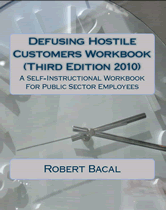
Gathering Customer Satisfaction Data Every Staff Member A Researcher by Robert Bacal
Last month we discussed the importance of measuring client satisfaction if one is interested in improving service quality. This month we are going to present to you an alternative to written feedback mechanisms that are sometimes complicated to administer and certainly rather costly in terms of the resources needed to make it work. The approach we are going to discuss focuses on using each and every staff member who interacts with clients in a systematic and organized process to gather client satisfaction information.
Introduction
Many organizations announce that their employees are their most valuable resources. While this phrase has lost its meaning in many organization, nowhere is it more appropriate than when discussing the gathering of information about client satisfaction levels. While surveys, response cards and the like can play important roles in data gathering, it is the staff that interact with clients every single day who have the best opportunities to gather data, and make sense of it so that service quality can be improved. We are going to take a look at how you might go about using your staff resources for this purpose.
Advantages of Using Staff as Primary Data Gatherers
Apart from the fact that staff are in every day contact with customers, let's look at some of the advantages of having staff actively involved in data collection regarding client satisfaction.
1. Since front line staff deal with clients everyday, they are in the best position to collect, organize and interpret the client comments and feedback.
2. Involving staff in a systematic way helps ensure that client feedback offered on a daily basis doesn't get lost forever.
3. Involving staff in an ongoing way indicates that a) you are serious about connecting with customers, and b) you respect the wisdom and abilities of your staff. As such it helps focus staff on quality service in a constructive, enabling way.
Starting Principles
To make a staff data gathering process work, we must consider the following:
1. The data gathering system must be organized so that staff understand what data will be useful and how that data should be elicited from customers.
2. There must be a system for recording the data in an organized way (check sheets or lists, structured reporting forms, etc).
3. There must be a forum for the reporting of that data, so that each collector knows that the information they collect is being heard and used.
4. Data collection MUST be accompanied by action on the data.
5. Support (e.g. training) needs to be available for any staff that want to improve their skills at eliciting customer perception information (e.g. training in questioning techniques, listening and empathy).
Implementation Steps
1. Groundwork
The process begins by a focus on customer perceptions and service improvement, even before anything specific begins. Managers/Leaders can lay this groundwork by broaching the subject of client perceptions, and service quality, including references in strategic planning, performance management interviews, etc. Essentially, the manager needs to build a more client focused culture before progress can be made.
2. Beginning Staff Involvement
Staff can be involved via group discussions or individual meetings. Managers can begin by asking some or all of the following questions:
How do we know if our clients are satisfied with our service?
How would we know if they didn't?
What do we need to know to find out about our clients' perceptions?
The answers to these questions can be converted into specific questions that staff can ask clients, as part of the regular client contacts.
3. Design Your Data Gathering Process
With staff, determine the questions that are deemed as high priority ones to pose to clients. In addition, identify how much information you need, who staff need to ask, and how information should be recorded (keep it simple).
4. Design Your Data Reporting Process
There must be ways for staff to be heard regarding the data they collect, and they must have an opportunity to access the data of others. Written summaries can be generated, but the more critical part is the discussion that is integrated with reporting the information.
5. Design Your Decision-Making/Action Process.
Make sure that the data collected is used to make decisions regarding service improvement. Everyone needs to be clear about how the data is going to be handled. For example, you might follow the following pattern at monthly staff meetings.
1. Data Summarizing & Reporting
2. Discussion/Interpretation
3. Action discussion/decision-making regarding improvement.
What is important is that the pattern be followed consistently -- no exceptions, and that time be allocated to the process, even when time is short.
6. Execute Plan
7. Evaluate Success
8. Revise Plan
An Example
Jackie Smothers is director of a branch that operates a storefront operation, where members of the public come in for information and service of various sorts. Due to the nature of the organization, the end of the month is their busiest time.
Jackie had several concerns about how the branch operated. First it bothered here that nobody could really say, with some confidence, how clients viewed what they did. While she was aware when complaints were registered, she realized that it was relatively rare that they received compliments, and nobody could really be sure what their clients liked, and what they didn't like.
Jackie started laying the ground work for involving staff in getting information from clients in a more systematic and organized way. Her first steps involved talking more to staff about the importance of continuous improvement and listening to customers' concerns. In addition, she decided it would be a good thing to revisit their role, mission and planning process to make sure that the client was placed "front and center" in their operation.
Staff seemed to enjoy the notion of becoming client centered, since, they said, they often were frustrated themselves with not knowing how they were doing, or not being able to find more reliable ways to offer satisfactory service.
At a staff meeting, Jackie introduced the notion that, as a client centered branch, they really needed to make decisions based not on guesses about their clients, but on more solid data. She asked staff (including the receptionists, phone staff, and counselors) how they felt about being involved in getting that information. Staff reaction was mixed. While most thought it was a good idea in principle, there were some concerns about how it would affect each individual.
Some of the comments and questions that arose included:
It's a good idea, but where would we find the time? I wouldn't know how to even go about it. I'm just not sure. Well, but what's the point of getting the information when it's the executives that really make the decision? What can we do, really?
Jackie responded to these and other concerns by indicating that she felt that, as a group, they had the resources to figure out a way to get the information and make use of it so that it didn't bog down the process; that it seemed that while they couldn't do everything on their own, they could focus on what they COULD control, and that if people felt they needed help in learning new skills she would do her best to make that available. at the conclusion of the meeting, Jackie asked that each staff member think about what kinds of information they would need, and how to go about the process.
In the course of further discussion (about one hour at each staff meeting), the group identified specific information they would need to get, and how they would make sure that any information was shared among all staff. It was decided that two days each month, staff would ask every fifth customers two questions regarding their perceptions of service quality. Each staff had an easy to use tally sheet to record the data. The first month's questions were simple: 1) How long did the customer wait (customer estimate)? and 2) Did the customers find the wait unreasonably long?
Each staff member took on responsibility for summarizing their findings for discussion at the regular staff meeting. At the monthly staff meetings twenty minutes was allocated to the summaries, and twenty five minutes allocated to coming up with suggestions to improve service in the area of interest. Occasionally, individual staff would be asked to take responsibility for coming up with additional suggestions.
Jackie noticed a few interesting things. First, not only did staff come to meetings with their summaries of the answers to questions, but they came with more information not specifically asked for in the questions. It turned out that the mere fact that staff were showing more interest in client perceptions make it easier for clients to make constructive suggestions about how to speed up the process. And, since staff knew that the information they gathered was going to be used, they seemed to remember things about client perceptions that they had never remarked upon before.
Through the process, Jackie and her staff were able to identify that, generally, the public did not mind waiting five minutes in line, but that at the end of the month the waits extended to over fifteen minutes at peak times. The branch decided this was not acceptable and worked towards reducing waiting times during peak periods. She was pleased to notice that many of their clients shared considerable praise -- something that they had not heard previously.
Over time, the process become routine. Several staff asked for some training in phrasing follow-up questions, and this was made available (several hours of training were made available).
Finally, Jackie found that it was far easier to encourage staff to focus on quality service by listening to clients, rather than trying to exhort them to perform according to management set criterion.





